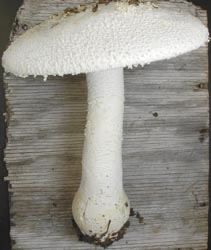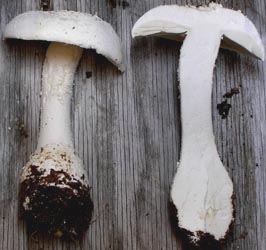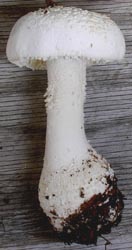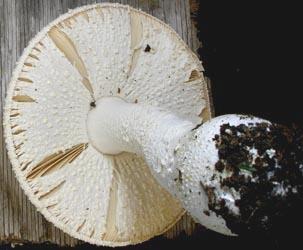|
[ Section Lepidella page. ]
[ Amanita Studies home. ]
[ Keys & Checklist/Picturebooks ] "Plateful of Pyramids Lepidella" =A. candida Peck =A. odorifera (Murrill) Murrill) =A. alexandri Guzmán
Technical description (t.b.d.) BRIEF DESCRIPTION: The cap of Amanita polypyramis is 70 - 180+ mm wide (and sometimes much larger) convex to plane, white, dry to subviscid, appendiculate, with a nonsulcate margin. The cao us 12,5 - 17 mm thick. It has a white, soft, pulverulent-subfloccose layer of volva on expansion of cap breaking up into small, conical warts up to 2 mm high and broad or shapeless, small, soft warts to patches or merely forming a flocculence over the whole cap or parts of it. The gills are crowded to subdistant, free to adnexed or just touching the stem, cream to yellowish cream in mass, white to cream to sordid cream in side view, and 7- - 13.5 mm broad. The short gills are attenuate. The stem is 76 - 180 x 10 - 35 mm (length includes length of bulb), equal or tapering upward, solid, white, usually exannulate, completely pulverulent-verruculose when young, and glabrescent with age. The stipe's bulb is 37 - 57 x 39- - 49 mm and subglobose to turbinate to irregularly oblong. The ring is copious, but fragile, white, decorated with large and small pieces of the volva's limbus internus on the underside. The spores measure (7.0-) 9.1 - 13.0 (-17.5) x (5.2-) 5.9 - 7.8 (-9.5) µm and are amyloid and ellipsoid to elongate (rarely cylindric). Clamps are absent at bases of basidia. The smell of this species is quite strong and in the "decaying protein" group. Bas (1969) created a stirps Polypyramis that includes the present species as well as A. boudieri Barla and A. pulverulenta Beeli. Recently, A. yenii Zhu L. Yang & C. M. Chen was described as belonging to the same stirps. The species was originally described from South Carolina, U.S.A. and is now known from the Pine Barrens of southern New Jersey to tropical Oak (Quercus) forest in Costa Rica. The species can be recognized by the plentiful small pyramids on the cap and bulb and by its tendency to produce very large fruiting bodies. The name A. alexandri Guzman was applied to diseased material of A. polypyramis as demonstrated by Morales-Torres et al. (1999). The strong odor of cheese from the "A. alexandri" specimens is associated with extensive penetration of the fruiting body by an as yet unidentified hyphomycete. -- R. E. Tulloss Photo : Dr. L. R. Hesler (top left, Tennessee, with permission of Dr. R. H. Petersen, L. R. Hesler Herbarium, Univ. of Tenn., Knoxville); Mr. Cornelius Hogenbirk (top right, southern New Jersey); R. E. Tulloss (middle & bottom, Great Smoky Mtns. Nat. Pk., Tennessee).
[ Section Lepidella page. ]
[ Amanita Studies home. ]
[ Keys & Checklist/Picturebooks ] Last changed 17 March 2009. |





